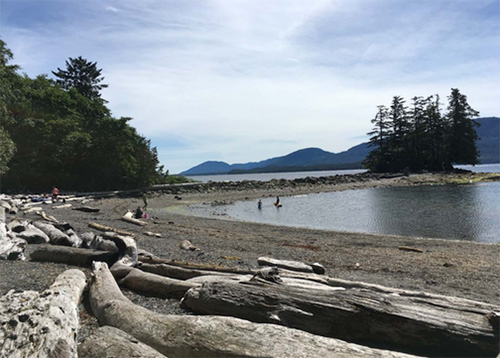
2017 Report for Bacteria at Coastal Areas in Ketchikan ReleasedBy MARY KAUFFMAN
February 01, 2018
The Alaska BEACH program was initiated along the Ketchikan coastline to monitor fecal waste contamination during the 2017 recreation season. Marine water samples were collected from July through September to evaluate potential health risks indicated by fecal coliform and enterococci bacteria, and to notify the public when levels exceeded state standards.
As part of a statewide recreational beach monitoring program, marine water samples were collected at nine Ketchikan coastal areas from July 18 to September 13, 2017. Due to elevated levels of bacteria, samples were also tested to see if the bacteria came from human sources. Samples were taken at South Refuge Cove Beach, Seaport Beach, Rotary Park Beach also known as Bugges Beach, Thomas Basin, Beacon Hill, Knudson Cove, South Point Higgins Beach, Sunset Beach, and Shull Beach. Ketchikan Indian Community assisted DEC in collecting the water samples. The report indicates recreation criteria for water quality were exceeded nearly every week from July 24 through August 29 at most of the nine locations. In addition, human fecal waste sources were associated with all of the nine monitoring locations along the Ketchikan coastline. Copies of previous public notifications are also incorporated into the report. The 2017 analytical tests for fecal coliform bacteria revealed that all nine of the monitoring sites failed to meet the Alaska water quality standard (WQS) single sample criteria for seafood processing, aquaculture and harvesting for consumption uses. Seven of the nine sites failed to meet the Alaska WQS geometric mean criterion for harvesting for consumption use and five of nine also failed the geometric mean criteria for seafood processing and aquaculture uses. For enterococci tests, eight of the nine monitoring sites failed to meet the Alaska WQS statistical threshold value (STV) criterion, and all nine of the sites failed to meet the Alaska WQS geometric mean criterion for the recreation use. In addition to bacteria testing, the Alaska Department of Environmental Conservation (DEC) began a source investigation of the pollution. Microbial source testing for bacteria genetic identification was also conducted. The human host marker was detected at all nine monitoring locations. One high use recreational beach also had dog and gull host markers detected, and a boat harbor known for youth recreational swimming/jumping had a gull host marker detected, as well as the human marker. Numerous potential bacteria sources are present along the Ketchikan coast, including: private and/or public sewer treatment system outfall(s), public treatment system emergency bypasses, sewer line breaks, individual septic tanks, wildlife, pet feces, boats in harbor and launch areas, cruise ships, private watercraft and ferries. Further bacteria and microbial source testing is planned by the Alaska Department of Environmental Conservation for the 2018 Ketchikan BEACH Monitoring Program which will help determine bacteria sources, and support the development of solutions and implementation of bacteria source reduction in these areas. According to the final Ketchikan Beach Monitoring report released yesterday, all potential bacteria sources will need to be better controlled to improve Ketchikan’s marine waters. The Alaska Department of Environmental Conservation's monitoring program will notify the public when levels exceed recreation criteria and will help support the development of recommendations for best management practices and wastewater treatment to reduce bacteria levels along the Ketchikan coastline. Since 2002, the DEC beach monitoring program has been collecting water quality samples at coastal recreation beaches throughout the state. According to the DEC, beaches were selected based on risk factors identified in community surveys. Other communities in Southeast Alaska have also been monitored including Douglas Island, Haines, Juneau, Petersburg, and Wrangell. DEC sample results have not shown persistent elevated levels of bacteria in these Southeast communities. Four press releases were distributed by the DEC to local media between August 11 and September 18, 2017 providing detailed monitoring information and precautionary measurements for the public to avoid exposure to bacteria impacted marine water. To further notify the public, the City of Ketchikan posted advisory signs at the beaches warning of elevated bacteria levels. The final report released on Jan. 31, 2018 was first expected to be released in November 2017. The Alaska Department of Environmental Conservation's monitoring program is part of a nationwide effort to decrease the incidence of water- borneillness at public beaches under the federal Beaches Environmental Assessmen tand Coastal Health (BEACH) Act, funded by an EPA BEACH grant to DEC.
On the Web:
Source of News:
Representations of fact and opinions in comments posted are solely those of the individual posters and do not represent the opinions of Sitnews.
|
|||
